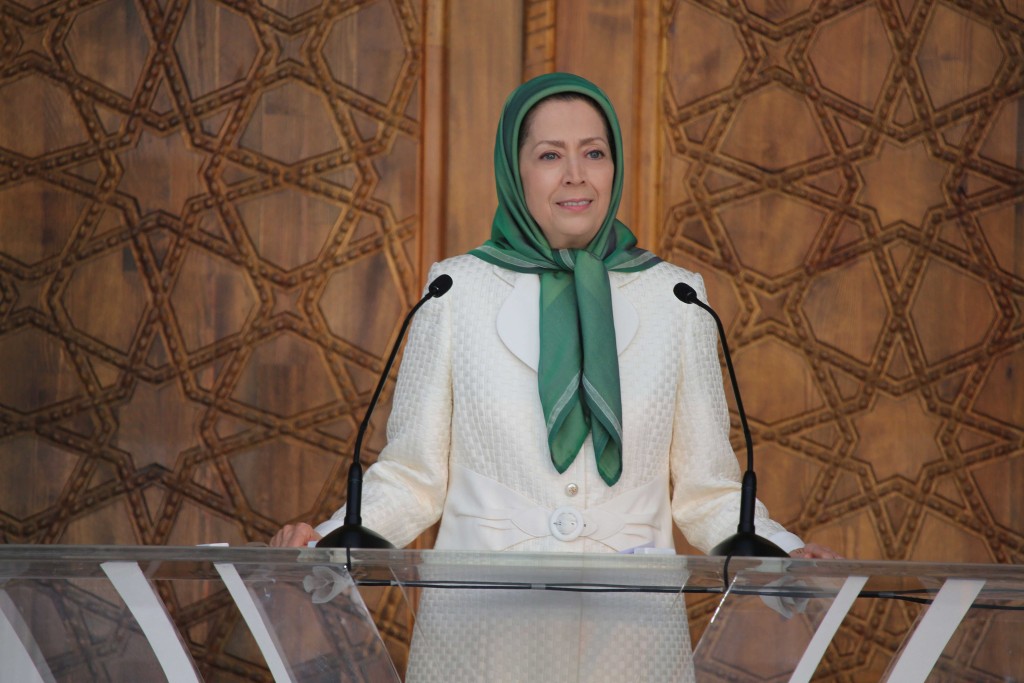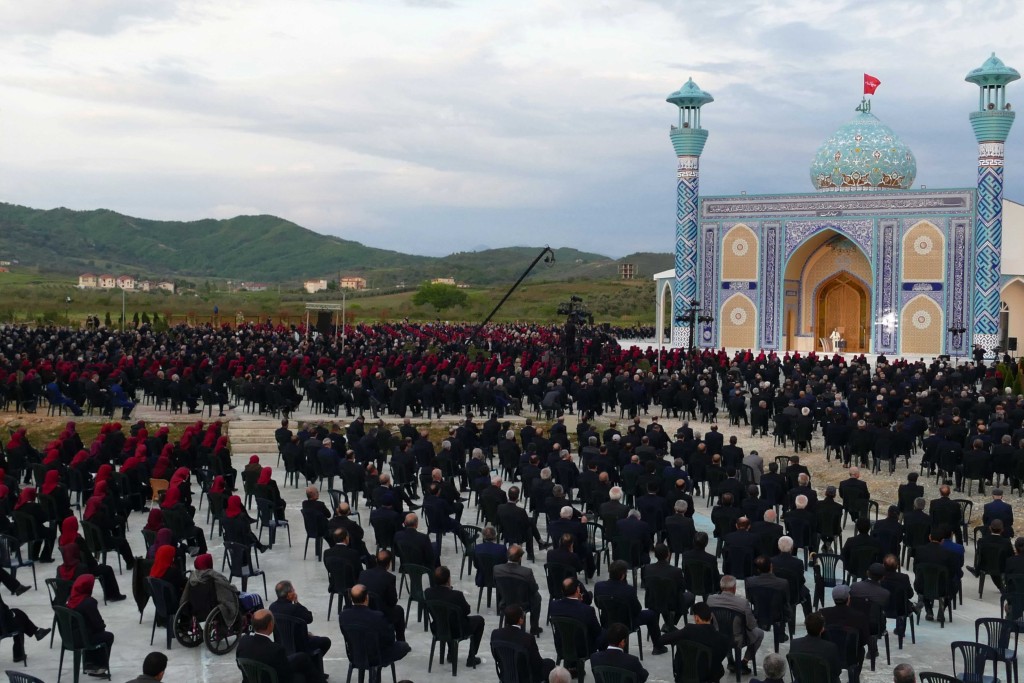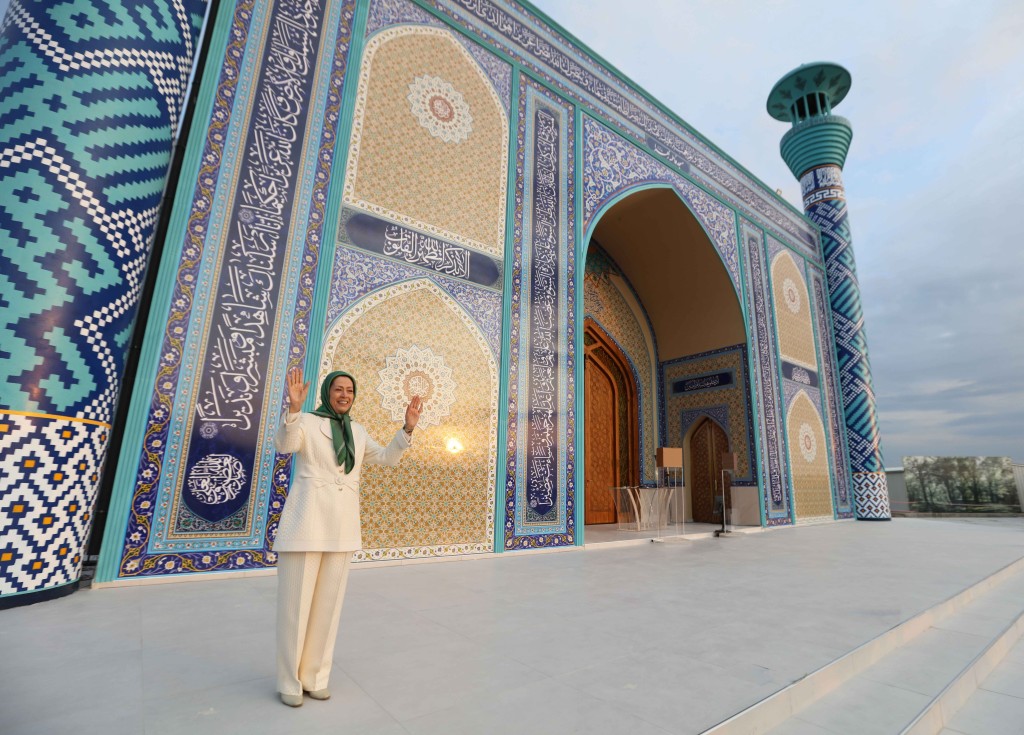Iranian people’s arduous journey will lead to victory and freedom

Hail to those persevering in the fasting and the great struggle against religious tyranny
Fellow compatriots,
Courageous members of the Resistance Units,
Members of the People’s Mojahedin of Iran,
Happy Eid al-Fitr to all of you and to all Muslims!
May those fasting and all our compatriots achieve increasing solidarity and unity of action against the mullahs’ religious dictatorship on this blessed day and in light of its messages.
Eid al-Fitr is the peak of all the fasting and victories in Ramadan. This year, we are celebrating it at the Fatemeh Zahra Mosque in Ashraf 3.
Fitr is the promise of freedom. This mosque is named after Fatemeh Zahra (the Prophet’s daughter). With the red flag of Imam Hossein and his slogan of Heyhat min az-Zellah (far be it from me to surrender to the enemy), it symbolizes the ongoing rebellion against the mullahs’ oppressive regime, which is a demagogic, inhumane, and misogynistic religious dictatorship.
This mosque is a place of worship for the pioneers who have found Islam as a messenger of freedom and emancipation. Inspired by it, they have risen up to struggle to break the shackles of their people.
This mosque stands against the clerical regime’s mosques of Dirar (dissent).
It is a loud cry to condemn the clerical regime. The mullahs falsely pray to justify the embezzlement of people’s property. They cover up the massacre of 30,000 political prisoners and the killing of 1,500 brave youths in the November 2019 uprising. They make the murder and wounding of daily laborers, freight carriers, and fuel carriers seem insignificant.
وَاَنْ تُدْخِلَنى فى كُلِّ خَيْرٍ اَدْخَلْتَ فيهِ مُحَمَّداً وَ الَ مُحَمَّدٍ وَاَنْ تُخْرِجَنى مِنْ كُلِّ سُوَّءٍ اَخْرَجْتَ مِنْهُ مُحَمَّداً وَ الَ مُحَمَّدٍ
As we recite in the prayer for Eid al-Fitr, may God Almighty liberate Iran and all Iranians from all evil, namely religious fascism. And may He lead them towards all goodness and beauty, namely establishing a republic and a democratic society based on freedom, equality, and justice.
The message of Fitr
The message of Eid al-Fitr is that the painful journey of the Iranian people will lead to freedom and victory. This is a universal celebration of liberation and a return to the essence of human nature.
Fasting and Ramadan are exercises to fight against coercion. Human society can liberate itself. But how?
In this way, human beings create themselves in the course of the struggle against natural, social and political blind fate.
Humans free themselves in the battle against what has condemned them to accept the status quo. Human progress has been the history of fighting against these coercions and compulsions from the beginning to this day.
The message of Eid al-Fitr is that man, after battling the coercions that govern him, rediscovers his nature and truth.
In this moment of awakening, one realizes that being and living free from captivity is possible.
We celebrate Eid al-Fitr because it is a sign that man has the power to liberate himself. It is a sign that the oppressed people can break the chains of captivity and take control of their bright destiny.
Eid al-Fitr is completed by paying a donation (Fitriyeh) equivalent to three meals. Its message is to feed the hungry and eradicate hunger from this world. The poverty of human beings must end. In this way, man treads the glorious path towards the age of the end of oppression and exploitation.

The Iranian people in poverty
Let’s have a glance at the painful poverty that pervades the majority of Iranian society today.
Look at the slender bodies of girls and boys looking for food in trash bins.
Look at the students who drop out of school due to poverty. Millions of teens are crushed under the pressure of arduous work for meagre wages, like the young girls who are crippled because of long hours of uninterrupted work at carpet weaving workshops.
Also, look at the five or six million female heads of households who do not know how to provide their family’s daily food. They do not know what to do for a child who becomes ill, with skyrocketing prices for medicine and treatment.
Look at the families whose breadwinners are freight or fuel carriers shot and killed or paralyzed by the IRGC. The millions who have no jobs and do not know where to find their bread. And all the homeless people and the poor people living in slums.
Ali Khamenei, Ebrahim Raisi, all the ruling mullahs, and the Revolutionary Guards (IRGC) must be blamed and condemned for abandoning the majority of the Iranian people in poverty and deprivation.
The Iranian people’s uprisings and protests are Khamenei’s nightmare. As a last resort, he appointed a mass murderer, Ebrahim Raisi, as president to control the situation. The regime, however, is in critical condition to the extent that their experts say that Raisi’s government is falling apart.
At the same time, the hunger and homelessness of the masses place a special responsibility on the shoulders of the leading force: eradicating hunger, poverty, and homelessness; eradicating murder, discrimination, and injustice. These values can only be achieved after the Iranian people are free and the repression is shattered.
The fitr or liberation of the Iranian people, including all religions and ethnicities, will be established based on freedom, equality, and solidarity and in the absence of oppression, reactionary thought, and deception.
Therefore, our true and lasting Eid will come when a sovereign government and a republic is in office. Such a government would rapidly move towards eradicating all forms of oppression and exploitation.
The mullahs have falsified and distorted the message of Islam in order to preserve their illegitimate and corrupt rule. They have perverted, abused, and altered the meaning of the verses of the Qur’an and the teachings of the Prophet and the Imams. Topping the list of perverted messages is a constant and consistent struggle for justice and the restoration of the rights of people.
The most basic principles and teachings of the Qur’an call on human beings to fight and destroy the idols and all the tyrants and oppressors who enchain people. Prophets from Noah to Abraham, Moses, Jesus, and Muhammed exemplify such teachings.
Islam prevents man from succumbing to political, social, and class compulsions in order to control his own destiny. It warns against ignorance towards human suffering, shunning inaction and irresponsibility towards tyranny and injustice by blood-thirsty regimes such as the mullahs’ religious dictatorship. Islam defines a human being’s identity through his/her sense of responsibility.
Wiping off the dust from religion
Since the outset, the Mojahedin understood Islam in the field of struggle to change the political, social, and economic relations of society. They gained their understanding of Islam and developed their vision on the battlefield. As we witnessed during their unjust trials under the Shah, Massoud Rajavi and other members of the PMOI’s Central Committee at the time roared with the same conviction and defended the deprived and oppressed masses.
The vanguard’s responsibility continues with full intensity and strength, at any time and any place, from the time of the Shah and his monarchical dictatorship to Khomeini, Khamenei, and the mullahs’ religious fascism.
For the Mojahedin, be it from Evin and Gohardasht prisons to the headquarters of the Alavi Foundation in Tehran, or the first Ashraf in the arid deserts of Iraq, to Camp Liberty, and Ashraf 3.
Yes, this is the message and meaning of Fatemeh Zahra Mosque from Ashraf 1 to Ashraf 3. Both have been and continue to remain symbols of a 57-year uninterrupted battle.
Like other Islamic institutions, concepts, and words throughout history, the mosque has been a place of worship for revolution and freedom. However, oppressive rulers and cunning mullahs have used it to suppress and deceive the masses of people.
In the history of Islam, the mosque’s history is very enlightening.
After migrating to Medina, the Prophet built a mosque there with his own hands. This mosque was a place of prayer and worship of God; it was also a place for decision-making and consultation in the struggle against ignorance and reactionary thought.
The mosque where Imam Ali prayed every day was also a place for hearing the people’s pains and problems. It was his headquarters for running the affairs during his five-year rule and wars. Imam Ali made many of his historical speeches and sermons on people’s rights and principles of justice in that mosque, where he was finally martyred.
In contrast, Mu’awiyah and Yazid, and other despotic rulers and caliphs turned the mosque into a place for cursing Ali and his followers.
The same bloody and irreconcilable confrontation has continued in our times.
When the Mojahedin launched their fight against the monarchical dictatorship, the mosques were a meeting place for them, their supporters, and the youths who opposed the regime.
Notable among all mosques was the Hedayat Mosque in Tehran, where Father Teleghani prayed, lectured, and interpreted the Quran. The initial gatherings of the families of the imprisoned Mojahedin also took place there. Hedayat Mosque had practically become one of the nerve centers of awareness for young and progressive Muslims.
On the eve of the 1979 Revolution, Massoud Rajavi, who had only been released from prison for three or four days, gave his first speech in the mosque of Tehran University. In that mosque, Massoud openly defended the Iranian people’s democratic revolution in diametric opposition to Khomeini’s “Islamic Revolution,” which seemed to be a dictatorship under the banner of Islam.
In the first Ramadan after the revolution, in August 1979, Massoud spoke at the mosque of Tehran University about Imam Ali’s rule and the constitution of an Islamic government. His speeches infuriated the ruling mullahs and unleashed their Hezbollahi hooligans against the Mojahedin.
In the same mosque, Moussa Khiabani taught six sessions of the philosophy of rituals from the PMOI‘s perspective, followed by his speeches on Ashura (martyrdom of Imam Hussein) as the philosophy of freedom.
In contrast, Khomeini used the ugliest and filthiest methods against mosques.
In practically every neighborhood, the mosque became a base of espionage, a place for Bassij mercenaries and criminals to protect the regime of ignorance and crime. In a word, the mosque turned into an institution of repression.
The mosque also reminds us of another significant oppression carried out under the mullahs’ rule, namely the suppression and trampling of the rights of our Sunni compatriots.
During the years of the mullahs’ rule, in many cases, the Revolutionary Guards or the infamous Ministry of Intelligence have destroyed Sunni mosques in Zahedan, Mashhad, Zabol, Bojnourd, Tehran, and other cities.
A large number of Sunni compatriots live in Tehran. But they are deprived of having even a single mosque, and they are not allowed to hold Eid al-Fitr prayers.
Indeed, what kind of Islam does not tolerate other Muslims’ prayers and destroys their mosques over their heads?
At Ashraf 1 in Iraq, the Fatemeh Zahra Mosque was a place of worship, kindness, and fraternity for Shiites and Sunnis alike. They prayed together and felt safe and united, away from the regime’s killings, explosions, and divisive acts.
When Massoud visited Mecca and Medina in 1987, he prayed behind the Sunni Imam in the Quba Mosque, the Prophet’s mosque in Medina, with his hands open in the Shiite style. Sunni worshipers warmly welcomed him into their ranks and kindly bid him farewell at the end of the prayer.
And today, we are in the Fatemeh Zahra Mosque in Ashraf 3, a symbol of the Mojahedin’s liberating Islam versus the Iranian regime and its anti-Islamic mullahs.
The Mojahedin’s mission has been to wipe off the dust from religion since the outset.
For five decades, Massoud has been the ideological leader of the Mojahedin and their revolutionary Islam in the struggle against the two dictatorships of the Shah and the mullahs. He discredited the mullahs’ reactionary regime at its foundations.
He also educated a generation of leading men and women in Iranian society based on the true spirit of Islam and the Qur’an. They freed themselves from reactionary and exploitative outlooks to rush to the aid of their people and save them from religious despotism.
Yes, we want and we must bring out the mosques from the mullahs’ clutches, a priority which we will achieve by overthrowing the Velayat-e-Faqih (absolute clerical rule) regime.
You certainly remember Massoud’s message to the fasting people and the revolutionary cells during the 2009 uprising about the need to liberate mosques from the regime’s hands.
One of the eternal role models for this revolutionary thought is Imam Hussein. His constant call to revolt against oppression and injustice summed up the meaning of life in having a cause and then fighting for it.
Today, on Eid al-Fitr, the PMOI/MEK, the people of Iran, and their children in the Resistance Units and the Liberation Army pray to God Almighty to bestow upon them ever-greater strength and resolve to overthrow the mullahs’ religious dictatorship.
On the anniversary of the martyrdom of Mohammad Zabeti and more than 60 members and commanders of the People’s Mojahedin in Tehran on May 2 and 9, 1982, we pay tribute to them. Their enormous sacrifice for freedom left a lasting lesson for Khomeini and his regime. O’ God, accept the gifts of this generation!
Almighty God, save the people of the Middle East from the warmongering and terrorism of the religious dictatorship ruling Iran!
Dear Lord, help the blood-drenched people of Ukraine in their resistance and grant them victory!
O’ God Almighty! Bring the Iranian people’s fitr of liberation closer and closer!
God bless you all.

- Tags: fundamentalism, Iran, Liberty, MEK, Mojahedin, mullahs' regime

